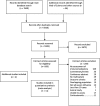Passive immune therapy and other immunomodulatory agents for the treatment of severe influenza: Systematic review and meta-analysis
- PMID: 31733048
- PMCID: PMC7040980
- DOI: 10.1111/irv.12699
Passive immune therapy and other immunomodulatory agents for the treatment of severe influenza: Systematic review and meta-analysis
Abstract
Background: A range of immunomodulatory therapies have been proposed as adjuncts to conventional antivirals to suppress harmful inflammation during severe influenza infection. We conducted a systematic review to assess available data of the effect of adjunctive non-corticosteroid immunomodulatory therapy and potential adverse effects.
Method: We searched MEDLINE, Embase, Web of Science and clinical trial databases for published and unpublished studies, and screened the references of included articles. We included RCTs, quasi-RCTs and observational studies of virologically confirmed influenza infections in hospitalised patients. We did not restrict studies by language of publication, influenza type/subtype or age of participants. Where possible, we pooled estimates of effect using random-effects meta-analysis models.
Results: We identified 11 eligible studies for inclusion: five studies (4 RCTs and 1 observational; 693 individuals) of passive immune therapy; four studies (3 RCTs and 1 observational; 1120 individuals) of macrolides and/or non-steroidal anti-inflammatory drugs (NSAIDs), one RCT of mTOR inhibitors (38 individuals), and one RCT of statin therapy (116 individuals). Meta-analysis of RCTs of passive immune therapy indicated no significant reduction in mortality (OR 0.84, 0.37-1.90), but better clinical outcomes at Day 7 (OR 1.42, 1.05-1.92). There was a significant reduction in mortality associated with macrolides and/or NSAIDs (OR 0.28; 0.10-0.77).
Conclusions: Passive immune therapy is unlikely to offer substantial mortality benefit in treatment of severe seasonal influenza, but may improve clinical outcomes. The effect of other immunomodulatory agents is uncertain, but promising. There is a need for high-quality RCTs with sufficient statistical power to address this evidence gap.
Keywords: adjunctive therapies; influenza; mortality; passive immune therapy.
© 2019 The Authors. Influenza and Other Respiratory Viruses Published by John Wiley & Sons Ltd.
Figures


Similar articles
-
Treating influenza with statins and other immunomodulatory agents.Antiviral Res. 2013 Sep;99(3):417-35. doi: 10.1016/j.antiviral.2013.06.018. Epub 2013 Jul 4. Antiviral Res. 2013. PMID: 23831494 Review.
-
The role of adjuvant immunomodulatory agents for treatment of severe influenza.Antiviral Res. 2018 Feb;150:202-216. doi: 10.1016/j.antiviral.2018.01.002. Epub 2018 Jan 8. Antiviral Res. 2018. PMID: 29325970 Free PMC article. Review.
-
Adjunctive therapies and immunomodulatory agents in the management of severe influenza.Antiviral Res. 2013 Jun;98(3):410-6. doi: 10.1016/j.antiviral.2013.03.019. Epub 2013 Apr 8. Antiviral Res. 2013. PMID: 23578727 Free PMC article. Review.
-
Adjunctive therapies and immunomodulating agents for severe influenza.Influenza Other Respir Viruses. 2013 Nov;7 Suppl 3(Suppl 3):52-9. doi: 10.1111/irv.12171. Influenza Other Respir Viruses. 2013. PMID: 24215382 Free PMC article. Review.
-
Immunomodulatory therapy for severe influenza.Expert Rev Anti Infect Ther. 2011 Jul;9(7):807-22. doi: 10.1586/eri.11.56. Expert Rev Anti Infect Ther. 2011. PMID: 21810053 Review.
Cited by
-
Infection with Influenzavirus A in a murine model induces epithelial bronchial lesions and distinct waves of innate immune-cell recruitment.Front Immunol. 2023 Aug 15;14:1241323. doi: 10.3389/fimmu.2023.1241323. eCollection 2023. Front Immunol. 2023. PMID: 37649477 Free PMC article.
-
Global variability of influenza activity and virus subtype circulation from 2011 to 2023.BMJ Open Respir Res. 2023 Jul;10(1):e001638. doi: 10.1136/bmjresp-2023-001638. BMJ Open Respir Res. 2023. PMID: 37491131 Free PMC article.
-
Efficacy of convalescent plasma for the treatment of severe influenza.Crit Care. 2020 Jul 29;24(1):469. doi: 10.1186/s13054-020-03189-7. Crit Care. 2020. PMID: 32727526 Free PMC article.
-
Safety and potential efficacy of cyclooxygenase-2 inhibitors in coronavirus disease 2019.Clin Transl Immunology. 2020 Jul 26;9(7):e1159. doi: 10.1002/cti2.1159. eCollection 2020. Clin Transl Immunology. 2020. PMID: 32728438 Free PMC article.
References
-
- WHO . Seasonal influenza. WHO. http://www.who.int/ith/vaccines/seasonal_influenza/en/. Accessed November 5, 2018.
-
- Uyeki TM, Bernstein HH, Bradley JS, et al. Clinical practice guidelines by the infectious diseases society of America: 2018 update on diagnosis, treatment, chemoprophylaxis, and institutional outbreak management of seasonal influenza. Clin Infect Dis Off Publ Infect Dis Soc Am. 2019;68:e1‐e47. - PMC - PubMed
-
- January 2019 P. PHE influenza antiviral treatment guideline. Guidelines. https://www.guidelines.co.uk/infection/phe-influenza-antiviral-treatment.... Accessed February 25, 2019.
Publication types
MeSH terms
Substances
Grants and funding
LinkOut - more resources
Full Text Sources
Medical
Miscellaneous

